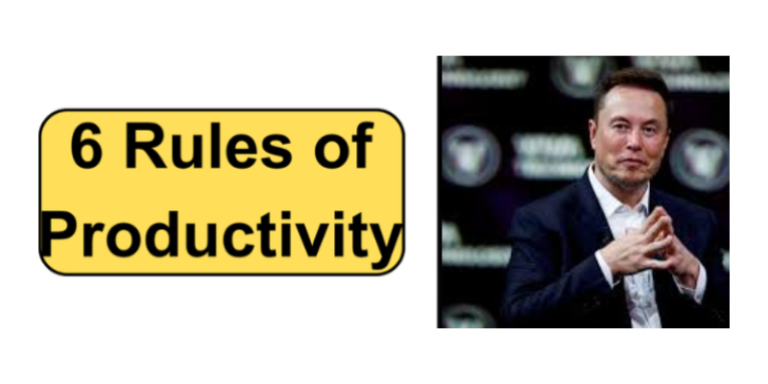Elon Musk’s productivity strategies are a testament to his innovative approach to management and efficiency. The tech mogul and serial entrepreneur has identified six rules of productivity and embedded them in his companies like SpaceX and Tesla Motors to maximise efficiency. These six rules encapsulate a philosophy designed to maximize output while minimizing wasted effort. In this article, we will explore these strategies in detail, drawing on relevant literature and expert opinions to contextualise their effectiveness.
1.0 Avoid Large Meetings
Large meetings are often criticised for being inefficient and unproductive. According to Allen (2001), meetings should be concise and focused, involving only essential participants. In Musk’s approach, large meetings are seen as a waste of time, reducing engagement and diluting responsibility. Similarly, Schwartzman (1989) emphasises that smaller, more focused meetings can enhance decision-making and ensure that all participants contribute meaningfully. This approach aligns with the principles of lean management, which advocates for the elimination of waste and maximisation of value (Womack & Jones, 2003).
2.0 Ditch Frequent Meetings
Frequent meetings can disrupt workflow and hinder productivity. Research by Luong and Rogelberg (2005) indicates that excessive meetings lead to increased fatigue and decreased job satisfaction. Musk’s recommendation to limit meetings to urgent issues and critical discussions resonates with the concept of ‘meeting effectiveness’ as discussed by Romano and Nunamaker (2001). Using alternative communication tools such as emails and chat messages for minor issues can help maintain workflow continuity and reduce unnecessary interruptions (Daft & Lengel, 1986).
3.0 Leave If You’re Not Contributing
Musk’s third rule stresses the importance of individual contribution. If a participant does not add value, they should feel free to leave the meeting. This principle is supported by the notion of ‘psychological safety’, which encourages open communication and the prioritisation of essential contributions (Edmondson, 1999). Respecting others’ time by attending only necessary meetings can foster a more efficient and respectful work environment (Cohen & Bailey, 1997).
4.0 Forget the Chain of Command
Traditional hierarchical structures can slow down decision-making processes. Musk advocates for bypassing the chain of command to accelerate communication and enhance efficiency. This approach is in line with the concept of ‘flat organisations’, which aim to reduce bureaucracy and promote faster decision-making (Hamel, 2007). Research by Spreitzer et al. (1999) suggests that empowering employees to communicate directly can lead to quicker resolutions and a stronger competitive advantage.
5.0 Be Clear, Not Clever
Effective communication is crucial for organisational success. Musk’s advice to use simple language rather than jargon is supported by the principles of plain language, which aim to make communication clear and accessible (Cutts, 2013). According to KISS (Keep It Simple, Stupid) principle, simplicity in communication enhances understanding and reduces the risk of misinterpretation (Heath & Heath, 2007). Being clear rather than clever ensures that messages are easily understood, facilitating better decision-making and collaboration (Cialdini, 2006).
6.0 Use Common Sense
Not all rules are applicable in every situation. Musk encourages the use of common sense, urging employees to apply their judgement based on the context. This principle echoes the ideas of situational leadership, which posits that leaders should adapt their style to the specific needs of the situation (Hersey & Blanchard, 1969). Using common sense involves critical thinking and the ability to discern which rules to apply in various scenarios (Kahneman, 2011). This flexibility can lead to more effective problem-solving and innovation (Sternberg, 2003).
Elon Musk’s six rules of productivity provide a framework for enhancing organisational efficiency and fostering a culture of responsibility and clarity. By avoiding large meetings, limiting the frequency of meetings, encouraging participation only when necessary, bypassing traditional hierarchies, prioritising clear communication, and applying common sense, these rules aim to create a more productive and engaged workforce. As supported by various studies and expert opinions, these principles can lead to significant improvements in organisational performance and employee satisfaction.
References
Allen, D. (2001) Getting Things Done: The Art of Stress-Free Productivity. Viking.
Cialdini, R. B. (2006) Influence: The Psychology of Persuasion. Harper Business.
Cohen, S. G., & Bailey, D. E. (1997) “What Makes Teams Work: Group Effectiveness Research from the Shop Floor to the Executive Suite”. Journal of Management. 23(3), pp. 239-290.
Cutts, M. (2013) Oxford Guide to Plain English. OUP Oxford.
Daft, R. L., & Lengel, R. H. (1986) „Organizational Information Requirements, Media Richness and Structural Design”. Management Science. 32(5), pp. 554-571.
Edmondson, A. (1999) “Psychological Safety and Learning Behaviour in Work Teams”. Administrative Science Quarterly. 44(2), pp. 350-383.
Hamel, G. (2007) The Future of Management. Harvard Business Review Press.
Heath, C., & Heath, D. (2007) Made to Stick: Why Some Ideas Survive and Others Die. Random House.
Hersey, P., & Blanchard, K. H. (1969) Life cycle theory of leadership. Training & Development Journal. 23(5), pp. 26-34.
Kahneman, D. (2011) Thinking, Fast and Slow. Farrar, Straus and Giroux.
Luong, A., & Rogelberg, S. G. (2005) “Meetings and More Meetings: The Relationship Between Meeting Load and the Daily Well-Being of Employees”. Group Dynamics: Theory, Research, and Practice. 9(1), pp. 58-67.
Romano, N. C., & Nunamaker, J. F. (2001) “Meeting Analysis: Findings From Research and Practice”. Journal Of Management Information Systems”. 17(3), pp. 263-294.
Schwartzman, H. B. (1989) The Meeting: Gatherings in Organizations and Communities. Springer.
Spreitzer, G. M., Cohen, S. G., & Ledford, G. E. (1999) “Developing Effective Self-Managing Work Teams in Service Organizations”. Group & Organization Management. 24(3), pp. 340-366.
Sternberg, R. J. (2003) Wisdom, Intelligence, and Creativity Synthesized. Cambridge University Press.
Womack, J. P., & Jones, D. T. (2003) Lean Thinking: Banish Waste and Create Wealth in Your Corporation. Free Press.









